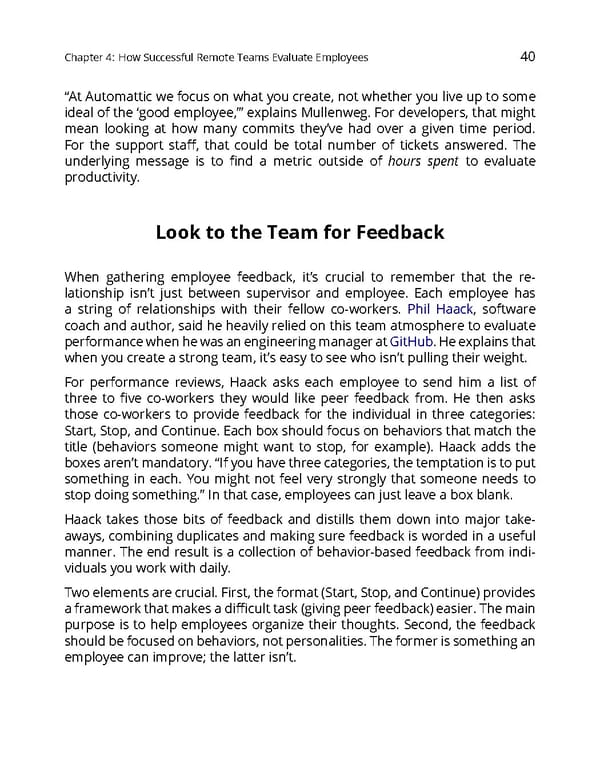Chapter4: HowSuccessfulRemoteTeamsEvaluateEmployees 40 “At Automattic we focus on what you create, not whether you live up to some ideal of the ‘good employee,’” explains Mullenweg. For developers, that might mean looking at how many commits they’ve had over a given time period. For the support staff, that could be total number of tickets answered. The underlying message is to find a metric outside of hours spent to evaluate productivity. LooktotheTeamforFeedback When gathering employee feedback, it’s crucial to remember that the re- lationship isn’t just between supervisor and employee. Each employee has a string of relationships with their fellow co-workers. Phil Haack, software coach and author, said he heavily relied on this team atmosphere to evaluate performancewhenhewasanengineeringmanageratGitHub.Heexplainsthat whenyoucreateastrongteam,it’seasytoseewhoisn’tpullingtheirweight. For performance reviews, Haack asks each employee to send him a list of three to five co-workers they would like peer feedback from. He then asks those co-workers to provide feedback for the individual in three categories: Start, Stop, and Continue. Each box should focus on behaviors that match the title (behaviors someone might want to stop, for example). Haack adds the boxesaren’tmandatory.“Ifyouhavethreecategories,thetemptationistoput something in each. You might not feel very strongly that someone needs to stop doing something.” In that case, employees can just leave a box blank. Haack takes those bits of feedback and distills them down into major take- aways, combining duplicates and making sure feedback is worded in a useful manner. The end result is a collection of behavior-based feedback from indi- viduals you work with daily. Twoelementsarecrucial.First,theformat(Start,Stop,andContinue)provides aframeworkthatmakesadifficulttask(givingpeerfeedback)easier.Themain purpose is to help employees organize their thoughts. Second, the feedback shouldbefocusedonbehaviors,notpersonalities.Theformerissomethingan employeecanimprove;thelatterisn’t.
 The Ultimate Guide to Remote Work Page 43 Page 45
The Ultimate Guide to Remote Work Page 43 Page 45